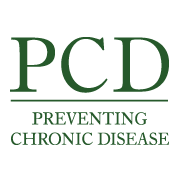PCD News Summary for December 8, 2016

About the Journal
Published every Thursday, Preventing Chronic Disease (PCD) is a peer-reviewed online journal established by CDC’s National Center for Chronic Disease Prevention and Health Promotion. The News Media Branch prepares press summary packets each week. To receive these press summaries on an embargoed basis, send an e-mail to media@cdc.gov. Please note that this e-mail list is for credentialed journalists only. All others, please visit Hookup to Health to sign up for e-mail updates
Notice to News Media – PCD Release Time and Embargo Policy:
CDC’s News Media Branch releases to reporters the PCD media packet every Tuesday afternoon between 12 and 2 pm.
Racial/Ethnic Differences in Associations between Neighborhood Social Cohesion and Meeting Physical Activity Guidelines, United States, 2013–2014
Melissa Newton
mnewton@cdc.gov
404-718-6281
Americans living in neighborhoods with higher levels of neighborhood social cohesion were more likely to participate in the recommended amount of aerobic physical activity and get the weekly recommended amount of moderate or moderate-equivalent minutes of physical activity. Researchers combined 2013 and 2014 data from the National Health Interview Survey to examine whether neighborhood social cohesion was associated with performing physical activity in a nationally representative dataset. Researchers defined neighborhood social cohesion as the perceived degree of connectedness between and among neighbors and their willingness to intervene for the common good. Neighborhood cohesion was highest among older, white, high-income, and educated adults. Among those living in more cohesive neighborhoods, white and Hispanic adults were more likely to exercise but black and Asian-American adults were not.
Strengthening the Connection between the Supplemental Nutrition Assistance Program and Farmers Markets
Melissa Newton
mnewton@cdc.gov
404-718-6281
More than half of farmers markets made available by the Washington State Department of Health by 2019 are projected to offer fruit and vegetable incentives to Supplemental Nutrition Assistance Program (SNAP) participants. Researchers assessed the geographic distribution of farmers markets offering affordable fruits and vegetables in relation to high-SNAP areas, urban and rural areas, and within specific drive times. The findings revealed opportunities to strategically expand incentive programming to markets that have the highest percentage of SNAP households within their service areas. These maps and the associated network analysis will be used to engage farmers markets and local food access program planners in future efforts to expand fruit and vegetable incentives to more markets and in communities with the most SNAP households.
###
U.S. DEPARTMENT OF HEALTH AND HUMAN SERVICES
CDC works 24/7 protecting America’s health, safety and security. Whether diseases start at home or abroad, are curable or preventable, chronic or acute, stem from human error or deliberate attack, CDC is committed to respond to America’s most pressing health challenges.